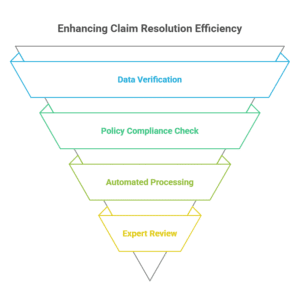On-Demand Outsourcing BPO Services for Healthcare Providers With 24/7 Coverage!
Save up to 70% on staffing costs!
Browse Specialty Staffing ServicesStrategies To Improve First-Pass claim Resolution Rate

In the complex world of medical billing, one metric stands out as a direct indicator of revenue cycle efficiency: the First-Pass Claim Resolution Rate (FPRR). This rate measures the percentage of insurance claims paid upon first submission without the need for rework. A high FPRR means fewer denials, faster reimbursements, and less administrative burden—making it a key performance metric for every healthcare provider or billing team.
Key Takeaways
-
What is First-Pass Claim Resolution Rate (FPRR)?
-
Common reasons for claim denials or rejections
-
Proven strategies to boost FPRR
-
Tools and technology that support better claim submissions
-
Final tips for long-term improvement
What Is First-Pass Claim Resolution Rate?
FPRR refers to the percentage of claims that are processed and paid by payers the first time they are submitted—without corrections, resubmissions, or appeals. A good benchmark is >90%, but many healthcare organizations struggle to consistently hit that mark due to various factors.
Common Causes of Low FPRR
-
Incomplete or inaccurate patient information
-
Incorrect coding (CPT, ICD-10, HCPCS)
-
Missing prior authorization or referrals
-
Not verifying insurance eligibility
-
Lack of real-time claim edits
-
Payer-specific submission errors
Top Strategies to Improve First-Pass Claim Resolution Rate

1. Enhance Patient Data Collection at the Front Desk
Ensure demographic details and insurance information are captured accurately during patient intake. Use digital forms and verification tools to avoid manual errors.
2. Verify Insurance Eligibility in Real-Time
Use electronic eligibility verification tools before every visit to confirm the patient’s insurance coverage, co-pay, deductibles, and authorization requirements.
3. Use Accurate and Updated Medical Coding
Invest in certified medical coders or reliable AI-powered coding software. Stay updated with annual coding changes and payer-specific rules.
4. Implement Pre-Bill Claim Scrubbing Tools
Claim scrubbers flag potential errors before submission. These tools can catch missing modifiers, incorrect diagnosis codes, and other common issues that lead to denials.
5. Automate the Prior Authorization Process
Delays and denials due to missing prior auths are preventable. Automation tools can track and manage authorization requests based on procedure codes and payer rules.
6. Conduct Regular Staff Training
Hold monthly coding and billing workshops to keep your billing staff aware of payer trends, common rejections, and updates in regulations.
7. Review Denial Trends Monthly
Analyze claim denial reports to identify repeat issues. Create a feedback loop between billing, front office, and clinical teams to fix root causes.
8. Customize Payer Rules in Your EHR/Billing System
Configure your software to follow payer-specific submission rules (e.g., place of service, coverage restrictions). This reduces avoidable rejections.
Case Study Example
A multi-specialty clinic was struggling with a low FPRR of 78%. After implementing a real-time eligibility tool and pre-bill scrubbing, their FPRR rose to 93% within three months. The denial rate dropped by 40%, and cash flow improved without increasing staff headcount.
Final Tips for Long-Term Success
-
Audit claims monthly to catch process gaps early.
-
Maintain strong communication between providers, coders, and billers.
-
Use KPIs like FPRR, denial rate, and days in A/R to track improvements.
-
Outsource claim processing if in-house capacity is limited.
What Did We Learn?
Improving your First-Pass Claim Resolution Rate isn’t just about faster payments—it’s about creating a smarter, more accurate, and sustainable billing workflow. With the right technology, staff training, and payer intelligence, healthcare practices can achieve high FPRR, reduce rework, and boost revenue.
What people are asking?
Q1. What is a good first-pass claim resolution rate?
A rate above 90% is considered good. Top-performing practices aim for 95% or higher.
Q2. Why do claims get denied on the first submission?
Common reasons include incorrect coding, missing patient info, lack of prior authorization, and eligibility issues.
Q3. How can we prevent claim rejections?
Use real-time eligibility tools, claim scrubbers, and accurate coding practices to catch errors before submission.
Q4. Does automation help improve FPRR?
Yes, tools like automated eligibility checks and claim scrubbing software significantly reduce human error and speed up claim processing.
Q5. How often should we review our FPRR performance?
Review it monthly, along with denial reports, to quickly identify and fix recurring issues.
Disclaimer
For tailored support and professional services,
Please contact Staffingly, Inc. at (800) 489-5877
Email : support@staffingly.com.
About This Blog : This Blog is brought to you by Staffingly, Inc., a trusted name in healthcare outsourcing. The team of skilled healthcare specialists and content creators is dedicated to improving the quality and efficiency of healthcare services. The team passionate about sharing knowledge through insightful articles, blogs, and other educational resources.
 Book a Demo to Build Your Team Today!
Book a Demo to Build Your Team Today!

 Read Case Studies
Read Case Studies 



 Virtual Medical Assistants
Virtual Medical Assistants



